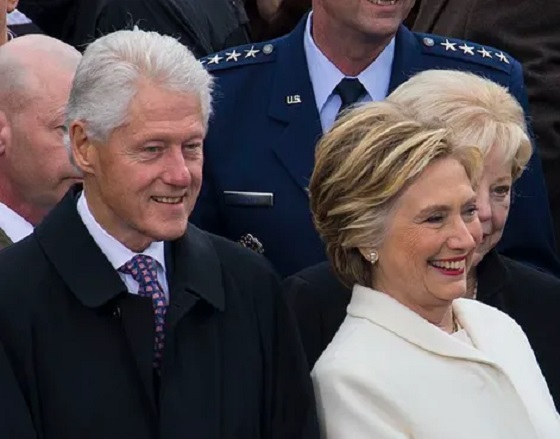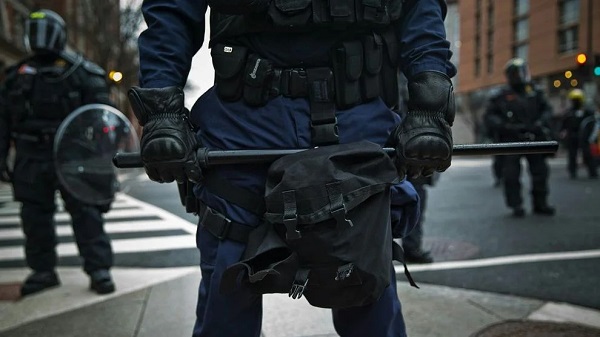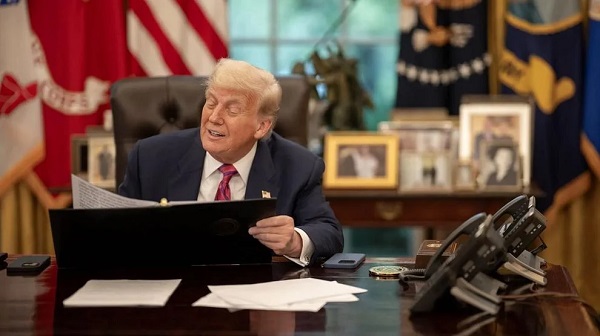International
Ghislaine Maxwell to be sentenced in Epstein sex abuse case

NEW YORK (AP) — Ghislaine Maxwell, the jet-setting socialite who once consorted with royals, presidents and billionaires, is set to be sentenced Tuesday for helping the wealthy financier Jeffrey Epstein sexually abuse underage girls.
The 11 a.m. sentencing in New York is the culmination of a prosecution that detailed how the power couple flaunted their riches and prominent connections to lure vulnerable girls as young as 14, and then exploit them.
Prosecutors said Epstein, who killed himself in 2019 while awaiting trial, sexually abused children hundreds of times over more than a decade, and couldn’t have done so without the help of Maxwell, his longtime companion and onetime girlfriend.
“Maxwell’s conduct was shockingly predatory. She was a calculating, sophisticated, and dangerous criminal who preyed on vulnerable young girls and groomed them for sexual abuse,” prosecutors wrote in a court filing.
In December, a jury convicted Maxwell of sex trafficking, transporting a minor to participate in illegal sex acts and two conspiracy charges. Prosecutors say she deserves 30 to 55 years in prison.
Maxwell, 60, has denied abusing anyone. Her lawyers have asked U.S. District Judge Alison J. Nathan to impose a sentence of no more than five years.
“The witnesses at trial testified about Ms. Maxwell’s facilitation of Epstein’s abuse, but Epstein was always the central figure: Epstein was the mastermind, Epstein was the principal abuser, and Epstein orchestrated the crimes for his personal gratification,” they wrote in a court filing.
Epstein and Maxwell’s associations with some of the world’s most famous people were not a prominent part of the trial, but mentions of friends like Bill Clinton, Donald Trump and Britain’s Prince Andrew showed how the pair exploited their connections to impress their prey.
Over the past 17 years, scores of women have accused Epstein of abusing them. Many described Maxwell as acting as a madam who recruited them to give massages to Epstein.
The trial, though, revolved around allegations from only a handful of those women.
Four testified that they were abused as teens in the 1990s and early 2000s at Epstein’s mansions in Florida, New York, New Mexico and the Virgin Islands.
Three were identified in court only by their first names or pseudonyms to protect their privacy: Jane, a television actress; Kate, an ex-model from the U.K.; and Carolyn, now a mom recovering from drug addiction. The fourth was Annie Farmer, who identified herself in court by her real name after speaking out publicly.
They described how Maxwell charmed them with conversation and gifts and promises that Epstein could use his wealth and connections to help fulfill their dreams.
Then, they testified, she led them to give massages to Epstein that turned sexual and played it off as normal.
Carolyn testified that she was one of several underprivileged teens who lived near Epstein’s Florida home in the early 2000s and took up an offer to massage him in exchange for $100 bills in what prosecutors described as “a pyramid of abuse.”
Maxwell made all the arrangements, Carolyn told the jury, even though she knew the girl was only 14 at the time.
The allegations against Epstein first surfaced publicly in 2005. He pleaded guilty to sex charges in Florida and served 13 months in jail, much of it in a work-release program as part of a deal criticized as lenient. Afterward, he was required to register as a sex offender.
In the years that followed, many women sued Epstein over alleged abuse. One, Virginia Giuffre, claimed that Epstein and Maxwell had also pressured her into sexual trysts with other powerful men, including Prince Andrew. All of those men denied the allegations and Giuffre ultimately settled a lawsuit against Andrew out of court.
Federal prosecutors in New York revived the case against Epstein after stories by the Miami Herald in 2018 brought new attention to his crimes. He was arrested in 2019, but killed himself a month later.
Eleven months later after his death, Maxwell was arrested at a New Hampshire estate. A U.S., British and French citizen, she has remained in a federal jail in New York City since then as her lawyers repeatedly criticize her treatment, saying she was even unjustly placed under suicide watch days before sentencing. Prosecutors say the claims about the jail are exaggerated and that Maxwell has been treated better than other prisoners.
Her lawyers also fought to have her conviction tossed on the grounds of juror misconduct.
Days after the verdict, one juror gave media interviews in which he disclosed he had been sexually abused as a child — something he hadn’t told the court during jury selection. Maxwell’s lawyers said she deserved a new trial. A judge disagreed.
At least eight women have submitted letters to the judge, describing the sexual abuse they said they endured for having met Maxwell and Epstein. Four of them plan to make oral statements at sentencing, including two women — Annie Farmer and Kate — who testified at the trial.
In letters to the judge, six of Maxwell’s seven living siblings pleaded for leniency.
Anne Holve and Philip Maxwell, her eldest siblings, wrote that her relationship with Epstein began soon after the 1991 death of their father, the British newspaper magnate Robert Maxwell.
They said Robert Maxwell had subjected her daughter to “frequent rapid mood swings, huge rages and rejections.”
“This led her to becoming very vulnerable to abusive and powerful men who would be able to take advantage of her innate good nature,” they wrote.
Prosecutors called Maxwell’s shifting of blame to Epstein “absurd and offensive.”
“Maxwell was an adult who made her own choices,” they wrote to the court. “She made the choice to sexually exploit numerous underage girls. She made the choice to conspire with Epstein for years, working as partners in crime and causing devastating harm to vulnerable victims. She should be held accountable for her disturbing role in an extensive child exploitation scheme.”
Larry Neumeister And Tom Hays, The Associated Press
Dr John Campbell
Cures for Cancer? A new study shows incredible results from cheap generic drug Fenbendazole

From Dr. John Campbell
You won’t hear much about Fenbendazole from the regular pipeline of medical information. There could be many reasons for that. For one, it’s primarily known for it’s use in veterinary medicine. Somehow during COVID the medical information pipeline convinced millions that if a drug is used on horses or other animals it couldn’t work for humans. Not sure how they got away with that one considering the use of animal trials for much of modern medical history.
Another possible reason, one that makes at least as much sense, is that there’s no business case for Fenbendazole. It’s been around for decades and its patent expired in the early 1990’s. That means it’s considered a generic drug that a pharmaceutical company from India could (and does) produce in mass quantities for very little profit (compared to non-generics).
So Fenbendazole is an inexpensive, widely accessible antiparasitic drug used in veterinary medicine. During the COVID pandemic a number of doctors, desperate for a suitable treatment, tried it with reportedly great levels of success. Over some time they discovered it might be useful elsewhere. Some doctors are using Fenbendazole to help treat late stage cancer. Often this is prescribed when the regular treatments clearly aren’t working and cancer is approaching or has already been declared stage 4.
What they’ve found at least in some cases is astounding results. This has resulted in a new study which medical researcher Dr. John Campbell shares in this video.
Business
Will Paramount turn the tide of legacy media and entertainment?


From the Daily Caller News Foundation
The recent leadership changes at Paramount Skydance suggest that the company may finally be ready to correct course after years of ideological drift, cultural activism posing as programming, and a pattern of self-inflicted financial and reputational damage.
Nowhere was this problem more visible than at CBS News, which for years operated as one of the most partisan and combative news organizations. Let’s be honest, CBS was the worst of an already left biased industry that stopped at nothing to censor conservatives. The network seemed committed to the idea that its viewers needed to be guided, corrected, or morally shaped by its editorial decisions.
This culminated in the CBS and 60 Minutes segment with Kamala Harris that was so heavily manipulated and so structurally misleading that it triggered widespread backlash and ultimately forced Paramount to settle a $16 million dispute with Donald Trump. That was not merely a legal or contractual problem. It was an institutional failure that demonstrated the degree to which political advocacy had overtaken journalistic integrity.
Dear Readers:
As a nonprofit, we are dependent on the generosity of our readers.
Please consider making a small donation of any amount here.
Thank you!
For many longtime viewers across the political spectrum, that episode represented a clear breaking point. It became impossible to argue that CBS News was simply leaning left. It was operating with a mission orientation that prioritized shaping narratives rather than reporting truth. As a result, trust collapsed. Many of us who once had long-term professional, commercial, or intellectual ties to Paramount and CBS walked away.
David Ellison’s acquisition of Paramount marks the most consequential change to the studio’s identity in a generation. Ellison is not anchored to the old Hollywood ecosystem where cultural signaling and activist messaging were considered more important than story, audience appeal, or shareholder value.
His professional history in film and strategic business management suggests an approach grounded in commercial performance, audience trust, and brand rebuilding rather than ideological identity. That shift matters because Paramount has spent years creating content and news coverage that seemed designed to provoke or instruct viewers rather than entertain or inform them. It was an approach that drained goodwill, eroded market share, and drove entire segments of the viewing public elsewhere.
The appointment of Bari Weiss as the new chief editor of CBS News is so significant. Weiss has built her reputation on rejecting ideological conformity imposed from either side. She has consistently spoken out against antisemitism and the moral disorientation that emerges when institutions prioritize political messaging over honesty.
Her brand centers on the belief that journalism should clarify rather than obscure. During President Trump’s recent 60 Minutes interview, he praised Weiss as a “great person” and credited her with helping restore integrity and editorial seriousness inside CBS. That moment signaled something important. Paramount is no longer simply rearranging executives. It is rethinking identity.
The appointment of Makan Delrahim as Chief Legal Officer was an early indicator. Delrahim’s background at the Department of Justice, where he led antitrust enforcement, signals seriousness about governance, compliance, and restoring institutional discipline.
But the deeper and more meaningful shift is occurring at the ownership and editorial levels, where the most politically charged parts of Paramount’s portfolio may finally be shedding the habits that alienated millions of viewers.The transformation will not be immediate. Institutions develop habits, internal cultures, and incentive structures that resist correction. There will be internal opposition, particularly from staff and producers who benefited from the ideological culture that defined CBS News in recent years.
There will be critics in Hollywood who see any shift toward balance as a threat to their influence. And there will be outside voices who will insist that any move away from their preferred political posture is regression.
But genuine reform never begins with instant consensus. It begins with leadership willing to be clear about the mission.
Paramount has the opportunity to reclaim what once made it extraordinary. Not as a symbol. Not as a message distribution vehicle. But as a studio that understands that good storytelling and credible reporting are not partisan aims. They are universal aims. Entertainment succeeds when it connects with audiences rather than instructing them. Journalism succeeds when it pursues truth rather than victory.
In an era when audiences have more viewing choices than at any time in history, trust is an economic asset. Viewers are sophisticated. They recognize when they are being lectured rather than engaged. They know when editorial goals are political rather than informational. And they are willing to reward any institution that treats them with respect.
There is now reason to believe Paramount understands this. The leadership is changing. The tone is changing. The incentives are being reassessed.
It is not the final outcome. But it is a real beginning. As the great Winston Churchill once said; “Now this is not the end. It is not even the beginning of the end. But it is, perhaps, the end of the beginning”.
For the first time in a long time, the door to cultural realignment in legacy media is open. And Paramount is standing at the threshold and has the capability to become a market leader once again. If Paramount acts, the industry will follow.
Bill Flaig and Tom Carter are the Co-Founders of The American Conservatives Values ETF, Ticker Symbol ACVF traded on the New York Stock Exchange. Ticker Symbol ACVF
Learn more at www.InvestConservative.com
-

 International2 days ago
International2 days agoUS announces Operation Southern Spear, targeting narco-terrorists
-

 Censorship Industrial Complex2 days ago
Censorship Industrial Complex2 days agoEU’s “Democracy Shield” Centralizes Control Over Online Speech
-

 Addictions1 day ago
Addictions1 day agoCanadian gov’t not stopping drug injection sites from being set up near schools, daycares
-

 International2 days ago
International2 days agoIs America drifting toward civil war? Joe Rogan thinks so
-

 Business1 day ago
Business1 day agoParliamentary Budget Officer begs Carney to cut back on spending
-

 International2 days ago
International2 days agoBondi and Patel deliver explosive “Clinton Corruption Files” to Congress
-

 International2 days ago
International2 days agoState Department designates European Antifa groups foreign terror organizations
-

 Bruce Dowbiggin2 days ago
Bruce Dowbiggin2 days agoDEI Or Die: Out With Remembrance, In With Replacement









